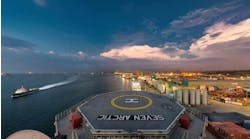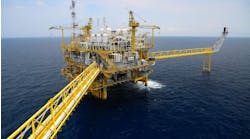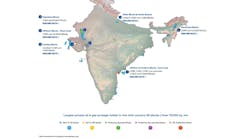The highly prospective nature of Australasia has increased its offshore exploration demand. This past May, the Australian minister for Resources and Energy awarded nine exploration permits representing a $425 million investment in Australia’s offshore petroleum sector. The take-up rate of acreage released yearly has risen from about 50% in 2002 to some 90% in 2007.
This unprecedented growth in the Asia-Pacific market has not come easy. The papers to be presented at PennWell’s DOT International Asia -Pacific 2008 in Perth, Australia, Dec. 3-5, 2008, recognize the deepwater technology issues operators have faced in exploring and developing hydrocarbon fields offshore Australasia.
Staying true to the conference theme, “The Next Generation of Deepwater Challenges,” the technical sessions include these main topics:
- Track 1: Floating Production Systems, Construction & Installation, Flowlines & Pipelines, and Mooring & Station-Keeping
- Track 2: Subsea Technology, Subsea Boosting & Processing, Risers & Riser Technology, and Flow Assurance
- Track 3: Lessons Learned – Deepwater, Field Architecture/Development Concepts, Well Construction, and Regional Challenges
The following summaries represent just some of the papers that will be presented at Offshore Asia-Pacific this year.
TRACK 1
New Semisubmersible Design for Ultra Deepwater Dry Tree Applications
Dr. Alaa Mansour, WorleyParsons Sea
A new conceptual semisubmersible design provides heave motion similar to a spar. Two features were added to the conventional semisubmersible designs to improve the platform heave and rotational responses. The new features are the stepped columns and the free-hanging solid ballast tank or heave plate. The new design installation technique and the interface with the top tensioned risers also are presented in this paper.
Offshore Deck Mating on a Floating Substructure in an Exposed Environment
Michel Seij, Dockwise Shipping b.v.
With increasing gas production in Australasia, a rising demand for offshore production facilities is forecasted. Dockwise will discuss the use of offshore deck mating for integration of floating production facilities. The presentation will include typicalities of an offshore deck mating on a floating substructure in an Australasian environment; an overview of the design and functionality of the new Friction Fender System to reduce relative motion between floating structures; development of a numerical analysis tool; and workability improvement using the Friction Fender System in various regions of the world, including Australasia.
Challenges and Solutions for Deepwater Pipeline Projects
Elizabeth Lakey, JP Kenny Pty Ltd.
The oil and gas market has pushed the industry to develop fields in deeper waters. JP Kenny will examine engineering challenges and solutions including routing the pipeline up steep slopes, long span management, flow assurance of waxy product in cold environments, subsea equipment technology gaps, pipeline design techniques including pressure protection systems, thermal buckling, collapse, and installation limitations.
Going Deeper and Safer: Global Response of Ultra Deepwater Floating Systems
Dr. Ming-Yao Lee, Chevron
This paper investigates limits and uncertainties in the prediction and verification of global responses for ultra deepwater floating facilities. A real-life design case will demonstrate how analysis and model tests can fit into the overall design process and provide a basis for the full-scale verification.
A Disconnectable FPSO with SCRs
Philippe Lavagna, SBM Atlantia
SBM Atlantia will give an overview of the existing FPSO technologies for deep, hurricane-prone waters, highlighting the need for a new mooring system concept to enable SCR use. The paper details the case study used to develop the company’s new concept called MoorSpar. The company will describe the main characteristics and capabilities of MoorSpar as used on an Aframax-size FPSO in 100-year winter storm and 100-year loop current conditions in the deep to ultra deep GoM.
Design of High Temperature/High Pressure Pipelines against Lateral Buckling Using Vertical Triggers
Arash Nikkihaah, Slt-Engineering Sdn Bhd
HT/HP pipelines are unique in the significant amount of compressive force that may develop in the pipeline due to interaction between pipeline and the seabed soil. The compressive force may lead the pipeline into second equilibrium configuration (pipeline bar buckling) to release some of the generated compressive force. Shape and overall conditions of the second equilibrium condition depends mainly on the boundary conditions of the pipeline. In this paper, Slt Engineering will use a case study to discuss lateral buckling of HP/HT pipelines.
In-Line Inspection for Deepwater Offshore Pipeline
Chris Yoxall, ROSEN Inspection
Rosen Inspection will discuss the challenges and technical solutions associated with intelligent pigging in deepwater pipelines, which is commonly associated with high pressure, high wall thickness, dual diameter, and a significant distance between the source of product and delivering point. The paper will take into consideration the minimum requirements needed to achieve a successful inspection, and the engineering challenges required to overcome the obstacle associated with deepwater pipelines.
TRACK 2
SAIPEM Framework for Future Deep and Ultra Deepwater Hybrid Riser Technology
Garry P Mahoney, SAIPEM SA - Saibos Division
SAIPEM will overview its framework and vision for the next generation of EPCI deep/ultra deepwater riser technology. The paper will describe drivers, objectives, and the “integrated building block” framework for typical future hybrid riser applications, and give several examples of targeted riser solutions.
Implementation of the World’s First All Electric Subsea Production Control System
Rory MacKenzie, Total E&P
In the summer of 2008, Total E&P, Netherlands went live with the world’s first all electric subsea production control system on the K5F development – a three slot wellhead protection structure designed for 2-4 wells tied back 18 km (11 mi) to an existing platform in the Dutch sector of the North Sea. This paper will review the current status of the evaluation.
Ultra Deepwater SCRs Design Challenges and Solutions for Semisubmersibles
Conor Galvin, MCS
This paper addresses the key issues for Steel Catenary Riser (SCR) design for ultra deepwater developments with semisubmersible hull facilities. Key issues addressed include a summary review of the historical development of SCR technology field development projects over the years; SCR strength design challenges and solutions; SCR fatigue design challenges and solutions; lessons learned from past GoM field development projects; and key technical issues for future ultra deepwater semisubmersible developments.
Deepwater Umbilical and Equipment Installation for the Independence Hub
Murray Dick, Subsea 7
This paper describes the installation of the 15 steel tube umbilicals and associated manifolds, subsea distribution units, stab and hinge over structures, flowline jumpers, and electrical and hydraulic flying leads for the Independence Hub field in the GoM. Subsea 7 outlines practical issues that arose from product loadout through completion of acceptance testing, details how they were dealt with, and explains the experiences and key learning’s developed from them. The newly developed Fibre Rope and Fibre Rope Deployment System was a key feature of the deepwater lifts.
A System for Measuring Wellhead Bending Moments during Completion Operations
Otávio de Brito Collaço Veras, 2H Offshore
A problem faced during completion operations is that if the vessel offsets and applied tensions are not carefully controlled, excessive bending loads can be applied to the wellhead and associated connectors. 2H Offshore has developed a novel monitoring system to address this issue. The paper will describe a system to measure bending moments in the wellhead, the theory behind the system, and how the recorded information is used to calculate the bending moment in the wellhead. It also addresses how the system is affected by different soil strengths, wellhead stickups, and environmental loadings.
Subsea Gas Compression
Håkon Skofteland, Aker Kvaerner Subsea
This paper describes a subsea compression system that Aker Kvaerner Subsea is building for the Ormen Lange pilot project. The subsea technology developed for the subsea compression system includes process, power distribution, and control system. The main modules of the process system are the separator, compressor, pump, and cooler. This is the world’s first subsea compression project and is setting the standard for subsea compression systems.
TRACK 3
Stybarrow, Offshore Australia’s Deepest Subsea Development
Robby O’Sullivan, TS7
The Stybarrow field is the deepest subsea development off Australia to date. This paper describes the installation engineering and operations associated with installing the infield flowline and umbilical system. The technical highlights include the world’s first use of Vetco JSS subsea tie-in system on flexible pipes, the difficulties associated with riser pull-in through a submerged spider buoy with a vertically “soft” mooring system, issues associated with umbilical terminations, and the use of a ROV removable clamp on a flexible riser.
Advanced Technologies
Salim Taoutaou, Schlumberger
This paper highlights experiences in deepwater and discusses the technology and expertise used to help Schlumberger’s customers improve efficiency and increase production. The paper describes deepwater challenges and solutions in Asia (Pakistan, Indonesia, and Malaysia) to achieve zonal isolation in conductors and surface casings. Schlumberger outlines several case histories for a number of major clients in Asia.
GAP Evolution Following Kikeh Project
Lionel Fromage, SBM Offshore Monaco
GAP (Gravity Actuated Pipe) is a near-surface fluid transfer system. It was installed in the Kikeh field off Malaysia in the South China Sea. This paper develops the technical lessons learnt in the course of the Kikeh GAP project execution and gives an overview of the interactions between design drivers. Furthermore, this paper presents the lines of development that have been identified with a view to adapting the system to longer lengths and/or harsher weather conditions and to optimizing further the product components.
The Impact of HP/HT on the Oil Industry
Brian Skeels, FMC Technologies
This paper outlines suggested design guidelines and areas of basic research that the oil and gas industry needs to address within standards committees and industry sponsored research programs to establish near term HP/HT application engineering, and longer term research into extreme HP/HT and ultra HP/HT environments.
The Virtual Control Buoy
Kevin Mullen, INTEC Engineering
The control of remote and deepwater all-subsea gas fields off Australia requires either long distance umbilicals or control buoys. This paper proposes using an Autonomous Underwater Vehicle to provide communication from the onshore control facility to the subsea wells. The paper addresses issues such as mission duration, launch and recovery, power generation on the seabed, and system reliability. This concept uses a number of existing proven technologies in a new way, which could provide technical and economic benefits for many of the large gas developments off the North West Shelf of Australia.
Overcoming Deepwater Challenges in the Middle East and Asia using Cementing NASNet, Long Term Positioning Technology for Deepwater Drilling Applications
John MacLeod, Nautronix
The current trends in the offshore oil and gas industry are to explore and develop resources in increasingly deeper areas, whilst reducing the basic costs involved. According to Nautroix, with NASNet it is commercially viable to provide field-wide positioning for the input to the vessel’s DP system. This negates the need to deploy, calibrate, and recover seabed beacons every time a vessel makes a location move. This paper will explore the technology used within NASNet, project considerations, and the benefits gained.


